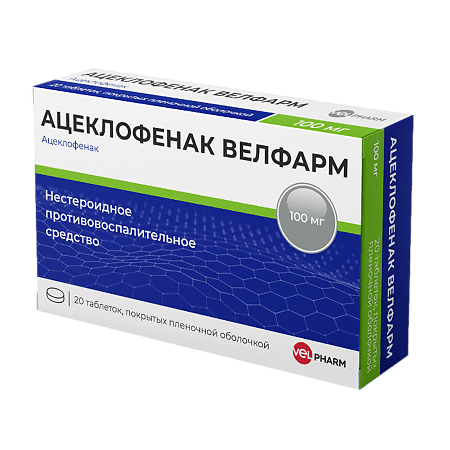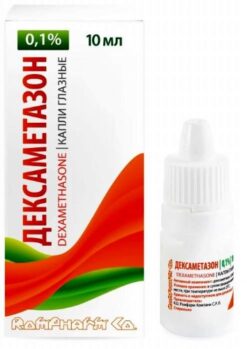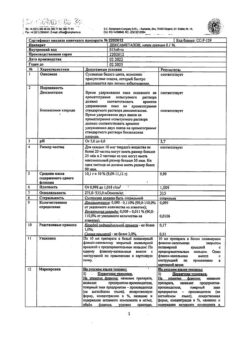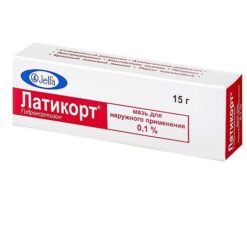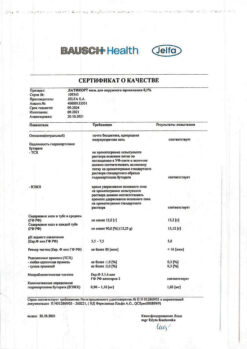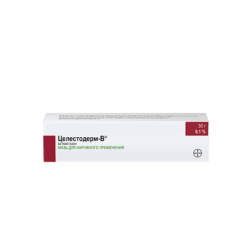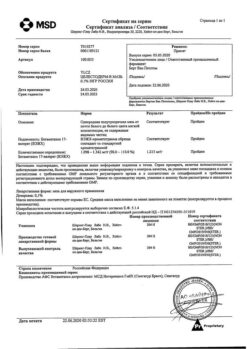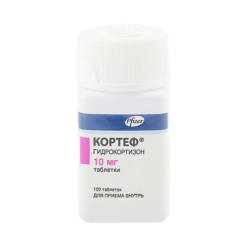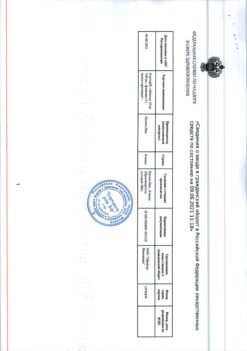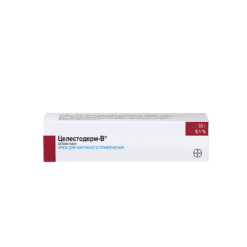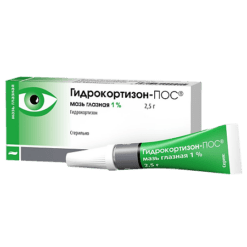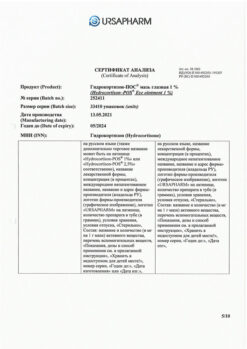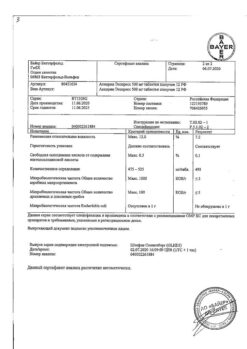No products in the cart.
Aceclofenac Welfarm, 100 mg 20 pcs
€11.77 €9.81
Description
Pharmacotherapeutic group: NSAIDs
ATC code: M01AB
Pharmacodynamics:
Aceclofenac is a derivative of phenylacetic acid inhibits cyclooxygenase types I and II.
It has anti-inflammatory analgesic and antipyretic effects.
It inhibits the synthesis of prostaglandins and thus influences the pathogenesis of inflammation, pain and fever. In rheumatic diseases the anti-inflammatory and analgesic activity of Aceclofenac promotes significant decrease of intensity of pain and swelling of joints which improves functional condition of the patient.
Pharmacokinetics:
Aceclofenac is quickly and completely absorbed after oral administration. The time of reaching maximum concentration is 125-3 h. It penetrates into synovial fluid where its concentration reaches 57% of the level of concentration in plasma and time of reaching maximum concentration 2-4 hours later than in plasma. The volume of distribution is 25 liters.
The binding to plasma proteins (albumin) is 99%. Aceclofenac circulates mainly unchanged its main metabolite is 4′-hydroxyacetylofenac.
Half-life period is 4 hours. It is excreted by the kidneys mainly as hydroxy derivatives (about 2/3 of the administered dose).
Indications
Indications
The drug is prescribed:
as part of complex treatment of inflammatory diseases of the musculoskeletal system (osteoarthrosis, rheumatoid, psoriatic and juvenile arthritis, arthritis, ankylosing spondylitis or spondylitis);
for the relief of pain and inflammation in rheumatism, toothache, and glenohumeral periarthritis.
The use of Aceclofenac is not able to completely cure these diseases, but quickly reduces inflammation and pain.
Pharmacological effect
Pharmacological effect
Pharmacotherapeutic group: NSAIDs
ATX code: M01AB
Pharmacodynamics:
Aceclofenac is a phenylacetic acid derivative that inhibits cyclooxygenase types I and II.
It has anti-inflammatory analgesic and antipyretic effects.
Inhibits the synthesis of prostaglandins and thus affects the pathogenesis of inflammation, pain and fever. In rheumatic diseases, the anti-inflammatory and analgesic effect of aceclofenac helps to significantly reduce the severity of pain, morning stiffness, swelling of joints, which improves the patient’s functional state.
Pharmacokinetics:
Aceclofenac is quickly and completely absorbed after oral administration. The time to reach maximum concentration is 125-3 hours. Penetrates into the synovial fluid where its concentration reaches 57% of the concentration level in plasma and the time to reach maximum concentration is 2-4 hours later than in plasma. Distribution volume – 25 l.
Connection with plasma proteins (albumin) – 99%. Aceclofenac circulates mainly unchanged; its main metabolite is 4′-hydroxyaceclofenac.
The half-life is 4 hours. It is excreted by the kidneys mainly in the form of hydroxy derivatives (about 2/3 of the administered dose).
Special instructions
Special instructions
The severity of adverse reactions can be adjusted by reducing the effective single dose required to control symptoms.
Patients with a history of arterial hypertension and/or chronic heart failure of NYMA functional class I-II require proper monitoring and consultation with a doctor because Fluid retention and edema have been reported during treatment with NSAIDs. Data from clinical and epidemiological studies suggest that the use of some NSAIDs (especially in high doses and long-term use) may increase the risk of arterial thrombosis (for example, myocardial infarction or stroke). There is insufficient data to exclude such a risk for aceclofenac.
Patients with uncontrolled arterial hypertension, congestive heart failure, coronary heart disease, peripheral artery disease and/or cerebrovascular disease should take aceclofenac only after a thorough analysis of the clinical situation. The same caution should be taken before starting long-term treatment in patients at risk of cardiovascular disease (for example, with arterial hypertension, hyperlipidemia, diabetes mellitus and smokers).
Aceclofenac should be taken with caution and under close medical supervision in patients with a history of gastrointestinal diseases such as peptic ulcers after an acute cerebrovascular accident, systemic lupus erythematosus, porphyria, disorders of the hematopoietic system and bleeding disorders.
Aceclofenac may cause reversible inhibition of platelet aggregation.
The drug is not recommended for patients with Crohn’s disease and ulcerative colitis. Caution should be exercised in patients with hepatic renal heart failure, as well as in patients with other diseases predisposed to the development of edema. Taking NSAIDs in this category of patients can lead to worsening renal excretion and the occurrence of edema.
Patients taking diuretics or with an increased risk of developing hypovolemia should also exercise caution when taking Aceclofenac Velpharm.
Caution should be exercised in elderly patients because… they are more likely to experience side effects. Gastrointestinal bleeding and/or perforation may occur during treatment, especially if there is a history of gastrointestinal diseases. In addition, older patients are more likely to develop liver, kidney, and cardiovascular dysfunction.
All patients receiving long-term treatment with NSAIDs require monitoring to reduce the risk of adverse reactions (for example, complete urinalysis, general and biochemical blood tests).
Concomitant use of Aceclofenac Velpharm with any drug that inhibits the synthesis of cyclooxygenase/prostaglandin can reduce fertility and is not recommended for women planning pregnancy.
Women with a history of infertility should stop taking Aceclofenac Velpharm.
Impact on the ability to drive vehicles. Wed and fur.:
During the treatment period, care must be taken when driving vehicles and engaging in other potentially hazardous activities that require increased concentration and speed of psychomotor reactions.
Active ingredient
Active ingredient
Aceclofenac
Composition
Composition
Composition per tablet:
Active ingredient:
Aceclofenac – 100 mg
Excipients:
Core composition:
Calcium stearate – 3 mg
Talc – 9 mg
Colloidal silicon dioxide (aerosil) – 1.5 mg
Microcrystalline cellulose – 85 mg
Croscarmellose sodium (primellose) – 10.5 mg
Lactose monohydrate (milk sugar) – 91 mg
Kernel weight – 300 mg
Shell composition: Opadry white 03F180011 – 10 mg (hypromellose – 60.0%, titanium dioxide – 25.0%, macrogol – 15.0%)
Tablet weight – 310 mg.
Contraindications
Contraindications
– Erosive and ulcerative lesions of the gastrointestinal tract in the acute phase, gastrointestinal bleeding or suspicion of it;
– complete or incomplete combination of bronchial asthma, recurrent polyposis of the nose and paranasal sinuses and intolerance to acetylsalicylic acid or other non-steroidal anti-inflammatory drugs (including a history);
– hypersensitivity to aceclofenac or components of the drug;
– the period after coronary artery bypass surgery;
– severe liver failure or active liver disease;
– severe renal failure (creatinine clearance less than 30 ml/min), progressive kidney disease, hyperkalemia;
– inflammatory bowel diseases (Crohn’s disease and ulcerative colitis) in the acute phase;
– decompensated heart failure;
– disorders of hematopoiesis and coagulation;
– pregnancy and breastfeeding;
– lactose deficiency, lactose intolerance, glucose-galactose malabsorption;
– children under 18 years of age.
With caution:
History of liver diseases, kidneys and gastrointestinal tract bronchial asthma arterial hypertension decreased circulating blood volume (including after surgery) coronary heart disease mild to moderate chronic renal failure (creatinine clearance from 30 to 60 ml/min) mild to moderate liver failure chronic heart failure cerebrovascular diseases dyslipidemia/hyperlipidemia. diabetes mellitus peripheral arterial disease smoking old age long-term use of NSAIDs in the medical history presence of Helicobacter pylori infection frequent alcohol consumption concomitant therapy with the following drugs:
anticoagulants (eg warfarin);
antiplatelet agents (for example acetylsalicylic acid clopidogrel);
oral glucocorticosteroids (eg prednisolone);
selective serotonin reuptake inhibitors (eg citalopram fluoxetine paroxetine sertraline).
Side Effects
Side Effects
The most frequently identified adverse reactions in clinical studies were from the gastrointestinal tract (dyspepsia – 75%; abdominal pain – 62%; nausea – 15%; diarrhea – 15%); sometimes – dizziness. An itchy rash and changes in the activity of liver enzymes and blood creatinine concentrations were also noted.
The undesirable effects listed below are presented by organ system classes in accordance with the MedDRA classification with the following frequency: often: ≥1/100 to <1/10; uncommon: ≥1/1000 to <1/100; rare: ≥1/10000 to <1/1000; very rare: < 1/10000.
Allergic reactions: skin rash urticaria eczema erythroderma systemic anaphylactoid reactions bronchial asthma in some cases – vasculitis pneumonitis multiform exudative erythema (including Stevens-Johnson syndrome) toxic epidermal necrolysis (Lyell’s syndrome).
From the immune system: rarely – anaphylactic reaction (including shock), hypersensitivity.
From the gastrointestinal tract: often – dyspepsia, abdominal pain, nausea, diarrhea; infrequently – flatulence gastritis constipation vomiting ulceration of the oral mucosa; rarely – melena, ulceration of the gastrointestinal tract, diarrhea with blood, gastrointestinal bleeding; very rarely – stomatitis, vomiting of blood, stomach ulcer, perforation of the small intestine, worsening of Crohn’s disease and ulcerative colitis, pancreatitis.
From the cardiovascular system: rarely – heart failure, increased blood pressure; very rarely – tachycardia “hot flashes” vasculitis.
From the liver and biliary tract: often – increased activity of liver enzymes; very rarely – liver damage (including hepatitis), increased blood alkaline phosphatase activity.
From the nervous system: often – dizziness; very rarely – paresthesia tremor drowsiness headache increased fatigue dysgeusia.
Mental disorders: very rarely – depression, atypical dreams, insomnia.
From the skin and subcutaneous tissue: infrequently – itching, rash, dermatitis, urticarial rash; rarely – angioedema; very rarely – purpura, reactions from the skin and mucous membranes, bullous skin reactions.
From the hematopoietic organs: thrombocytopenia, leukopenia, agranulocytosis, hemolytic anemia, aplastic anemia.
From the blood and lymphatic system: rarely – anemia; very rarely – bone marrow suppression, granulocytopenia, neutropenia, hemolytic anemia.
From the kidneys and urinary tract: infrequently – increased blood urea concentration, increased blood creatinine concentration; very rarely – interstitial nephritis, nephrotic syndrome, renal failure.
From the respiratory system of the chest and mediastinum: rarely – shortness of breath; very rarely – bronchospasm.
From the side of the organ of vision: rarely – visual impairment.
From the organ of hearing and labyrinth: very rarely – vertigo, tinnitus.
Metabolism and nutrition: very rarely – hyperkalemia, weight gain.
Systemic disorders: very rarely – muscle spasms of the lower extremities.
Interaction
Interaction
No drug interaction studies have been conducted with the exception of warfarin.
Aceclofenac is metabolized by the cytochrome P450 – CYP2C9 system and in vitro data indicate that aceclofenac may be an inhibitor of this enzyme. Therefore, there is a possible risk of pharmacokinetic interaction with phenytoin, cimetidine, tolbutamide, phenylbutazone, amiodarone, miconazole, and sulfaphenazole.
As with other NSAIDs, there is a risk of pharmacokinetic interaction with drugs whose metabolism occurs in the liver such as methotrexate and lithium preparations.
Aceclofenac is almost completely bound to plasma proteins and therefore it is necessary to consider the possibility of substitution with other drugs that are highly bound to plasma proteins.
Due to the lack of pharmacokinetic interaction studies, the following information is based on information obtained with other NSAIDs:
The following combinations should be avoided
NSAIDs suppress the tubular secretion of methotrexate and a metabolic interaction may also occur leading to a decrease in methotrexate clearance. Therefore, during treatment with large doses of methotrexate (more than 20 mg/week), NSAIDs should always be avoided.
Some NSAIDs inhibit the renal excretion of lithium, resulting in elevated serum lithium concentrations. This combination should be avoided unless frequent monitoring of serum lithium concentrations is possible.
NSAIDs inhibit platelet aggregation and damage the gastrointestinal mucosa, which may increase the activity of anticoagulants and increase the risk of bleeding from the gastrointestinal mucosa in patients taking anticoagulants.
The combination of aceclofenac with oral anticoagulants of the coumarin group, ticlopidine, thrombolytics and heparin should be avoided unless carefully monitored.
The following combinations may require dose adjustment and precautions:
It is necessary to take into account the possible interaction of NSAIDs and methotrexate, especially in patients with renal failure. When taking both drugs, monitoring of kidney function is necessary.
Precautions should be taken when taking NSAIDs and methotrexate simultaneously within 24 hours because methotrexate concentrations may increase leading to increased methotrexate toxicity. It is believed that taking NSAIDs with cyclosporine or tacrolimus increases the risk of nephrotoxicity due to decreased renal prostacyclin synthesis. Therefore, when taking drugs simultaneously, it is important to monitor renal function.
Concomitant use of acetylsalicylic acid and other NSAIDs may increase the incidence of adverse reactions and therefore caution is required when taking them together.
NSAIDs may reduce the diuretic effect of furosemide bumetanide and the hypotensive effect of thiazide diuretics. Simultaneous treatment with potassium-sparing diuretics may be associated with an increase in the concentration of potassium in the blood serum; therefore, monitoring of the potassium level in the blood is necessary.
NSAIDs may also reduce the effect of some antihypertensive medications.
Angiotensin-converting enzyme inhibitors or angiotensin II receptor antagonists in combination with NSAIDs can lead to renal failure. The risk of developing acute renal failure, which is usually reversible, may be increased in some patients with impaired nocturnal function, such as elderly patients or patients experiencing fluid deficiency. Therefore, the combination of such drugs with NSAIDs should be used with caution; patients should receive sufficient fluids with food and kidney function should be monitored.
There was no effect of aceclofenac on blood pressure when it was taken concomitantly with bendroflumethiazide, although interaction with other antihypertensive drugs such as beta-blockers cannot be excluded.
Other possible interactions
Isolated cases of hypoglycemia and hyperglycemia have been reported. Therefore, for aceclofenac it is necessary to adjust the dose of drugs that cause hypoglycemia.
When used simultaneously with the drug Aceclofenac Velpharm:
– digoxin phenytoin or lithium preparations – the plasma concentration of these drugs may increase;
– diuretics and antihypertensive drugs – the effect of these drugs may be weakened;
– potassium-sparing diuretics – can lead to the development of hyperglycemia and hyperkalemia;
– other NSAIDs or glucocorticosteroids – increases the risk of side effects from the gastrointestinal tract;
– selective serotonin reuptake inhibitors (citalopram fluoxetine paroxetine sertraline) – increases the risk of gastrointestinal bleeding;
– cyclosporine – the toxic effect of the latter on the kidneys may increase;
– hypoglycemic agents – can cause both hypo- and hyperglycemia. With this combination of drugs, blood sugar control is necessary;
– acetylsalicylic acid – the concentration of aceclofenac in the blood decreases;
– antiplatelet agents and anticoagulants – the risk of bleeding increases (regular monitoring of blood clotting indicators is necessary);
– zidovudine – increases the risk of hematological toxicity.
Overdose
Overdose
Symptoms: dizziness, headache, hyperventilation of the lungs with increased convulsive readiness, nausea, vomiting, pain in the abdomen.
Treatment: gastric lavage, administration of activated carbon, symptomatic therapy. There is no specific antidote. Forced diuresis, hemodialysis, and blood transfusions are ineffective.
Storage conditions
Storage conditions
In a place protected from light at a temperature not exceeding 25 ° C.
Keep out of the reach of children.
Shelf life
Shelf life
3 years.
Manufacturer
Manufacturer
Velfarm LLC, Russia
Additional information
| Shelf life | 3 years. |
|---|---|
| Conditions of storage | In the dark place at a temperature not exceeding 25 ° C. Store out of the reach of children. |
| Manufacturer | Welfarm, Russia |
| Medication form | pills |
| Brand | Welfarm |
Related products
Buy Aceclofenac Welfarm, 100 mg 20 pcs with delivery to USA, UK, Europe and over 120 other countries.

